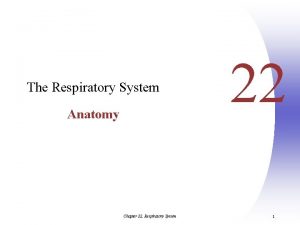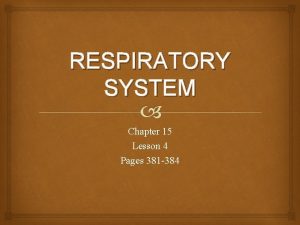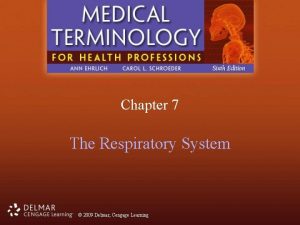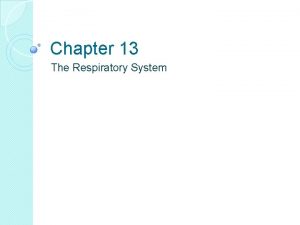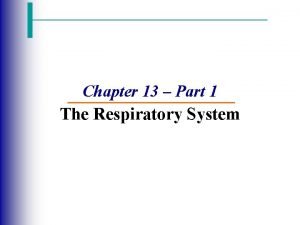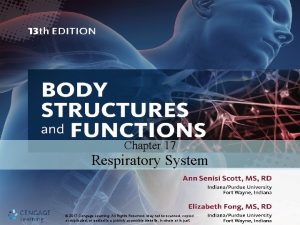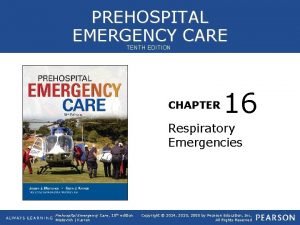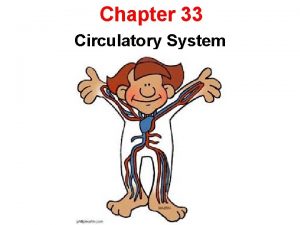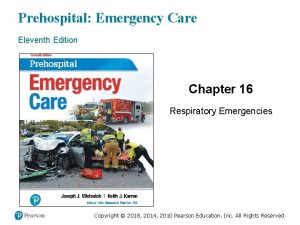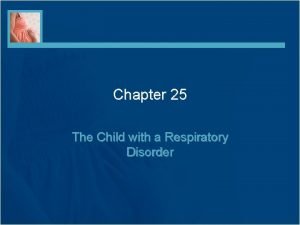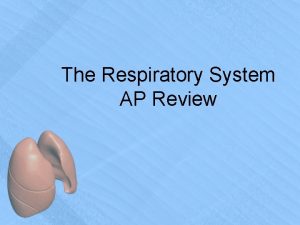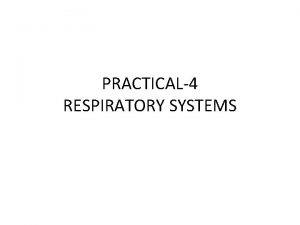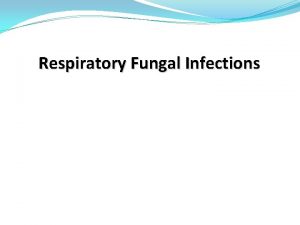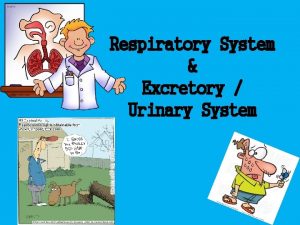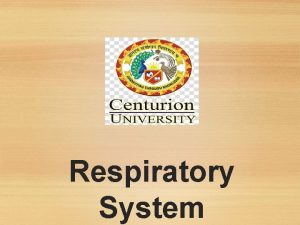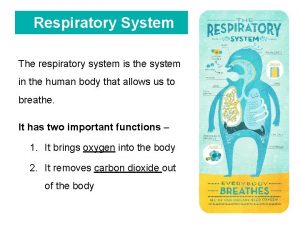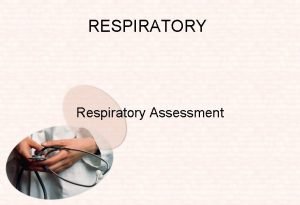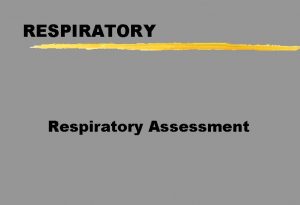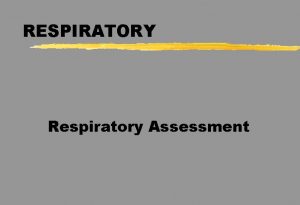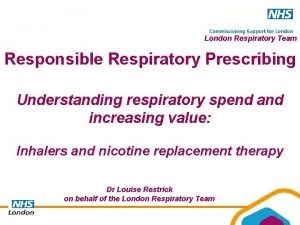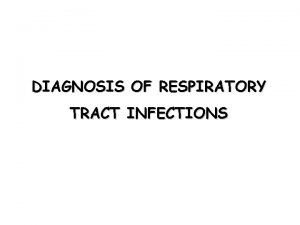Chapter 16 The Respiratory System The Respiratory System






































- Slides: 38

Chapter 16: The Respiratory System

The Respiratory System • The respiratory system, when viewed from a toxicological perspective, is important in that it – Provides an early warning detection system via olfaction for many airborne toxicants – Provides an exposure pathway for systemic exposures to many toxicants – Is a direct target of toxicity from exposures to many airborne chemicals and from some that have been orally consumed – Is an important organ system for many xenobiotic biotransformations

The Respiratory System, cont. • The respiratory system is subjected to frequent assault by airborne environmental contaminants. – The average adult inhales approximately 12 kg of air daily, although this value may increase dramatically with physical activity or exertion. • Compared with average daily food (1. 5 kg) or water (2 kg) intake, it is obvious that inhaled air is a major source of potential exposures to environmental toxicants.

The Respiratory System, cont. • At times, the concentration of airborne chemical contaminants increases to levels immediately dangerous to life and health: – The accidental release of 40 tons of methyl isocyanate in Bhopal, India in 1984 – A short-term inversion of smoke and sulfur dioxide in London, England in 1952 resulted in thousands of deaths, principally among the sick and elderly.

The Respiratory System, cont. • These episodes illustrate the danger that concentrated air pollution may pose. They also offer additional insight into the potential hazards posed by lower concentration chronic exposures and their role in the pathogenesis and exacerbation of respiratory disorders like chronic bronchitis and bronchial asthma.

The Respiratory System • The respiratory system is responsible for: – maintenance of life through gas exchange – many nonrespiratory functions like: • immune system maintenance • Metabolism of endogenous substances like angiotensin • Metabolism of environmental pollutant

The Respiratory System, cont. • The respiratory system plays an important role in: – – Recognition of xenobiotics Metabolism of xenobiotics Detoxification of xenobiotics elimination of xenobiotics • The surface epithelium of the respiratory system is an interface exposed to external contaminants via inhaled breath.

The Respiratory System • Inhaled air contains: – – A variety of nonessential gases Vapors Aerosols Particulates • All of these may possess the capacity to induce local injury or systemic injury. • The respiratory system can provide a route for systemic toxicants in addition to those that target the system directly. – For example, nitrogen dioxide can cause pulmonary fibrosis upon inhalation without producing systemic toxicity.

Systemic Toxicities Through Respiratory Exposure

Nomenclature of Airborne Toxicants • Gases: Of high water solubility where they readily dissolve in the nasal passages, upper airways (e. g. , sulfur dioxide); limited water solubility where movement into the deeper airways and alveolar region occurs (e. g. , O 2, CO 2, O 3, NO 2) • Vapor: Normally a liquid or solid at STP, but due to their high vapor pressure they volatize (e. g. , alcohols, ethers, gasoline) • Aerosols: Relatively stable suspensions of solids and/or liquid particles or droplets in the air • Dusts: Small particles of primary material, produced by abrasive processes such as sanding, grinding, or milling (e. g. , metals, silica, grains)

Nomenclature of Airborne Toxicants • Fumes: Produced by combustion, sublimation, or condensation of vaporized material; size tends to be <0. 31 μm (e. g. , zinc vapors and metal fume fever) • Smoke: Particles produced by combustion of organic matter • Mists and fogs: Condensation of moisture on particulate nuclei in air or by the uptake of liquid by hydroscopic particles (e. g. , the condensation of SO 2 [a water-soluble gas] onto particles of ash that penetrate deeply into the lung) • Smog: Mixture of smoke, particles, and gases (fog) produced by automotive exhaust and other combustion processes and formed by action of sunlight on oxides of nitrogen and volatile organics

Functional Divisions of the Respiratory System There are three functional divisions of the respiratory system: – Nasopharyngeal – Tracheobronchial – Pulmonary (alveolar or gas exchange surfaces) Particulate matter settles in these regions by: inertial impaction (nasopharyngeal) – sedimentation (trachea to bronchioles) – diffusion (alveoli)

Functional Divisions of the Respiratory System

Respiratory System Injury • Although there may be numerous potentially injurious chemicals in the air, the responses of the respiratory system generally fall into one or more of the following categories: – – – Irritative or inflammatory Bronchoconstrictive Fibrotic Oncogenetic Necrotic

Respiratory System Injury, cont. • The type and extent of injury depend on the: – concentration of the pollutant – Dose – duration of exposure – Physiochemical properties of the chemical

Exposures to Air Pollutants • Epidemiological studies have clearly demonstrated a link between air pollutants such as ozone, particulate matter, SO 2, and others with acute responses such as the exacerbation of asthma in the general population. – Exposure to ozone (one of the criteria pollutants) is known to induce increases in airway inflammation in nonasthmatics. – Low ozone concentrations, even brief exposures, are thought capable of triggering a low grade inflammatory response. – In asthmatics the effect of ozone is exaggerated, producing bronchoconstriction, increased neutrophilic inflammation, and increased sensitivity to allergens. – Ozone is found naturally in the upper atmosphere and closer to the ground as a component of air pollution.

Exposures to Air Pollutants, cont. – Concentrations typically spike in the summer when oxides of nitrogen and hydrocarbons react to form ozone. – There are concurrent increases of other pollutants such as sulfuric and nitric acids that may potentiate the irritant effects of ozone on the respiratory system. – It has been demonstrated that ozone is a potent pulmonary irritant, even in healthy individuals. – Short-term exposure to low level concentrations can produce symptoms that include chest tightness, increased airway resistance, increased mucociliary transport, and increased respiratory epithelial cell permeability. – Ozone is less soluble than many other irritant gases and penetrates into the pulmonary regions more effectively.

Exposures to Air Pollutants: Nitrogen Oxide • Like ozone, nitrogen oxides effectively penetrate deep into the respiratory system. – Exposure to nitrogen oxides triggers pathological changes in distal and alveolar regions of the respiratory system; these changes are characterized by proliferation of Clara and Type II cells. – Acute exposures to both ozone and nitrogen oxides can result in pulmonary edema, and chronic exposures may be linked to emphysema.

Exposures to Air Pollutants: Sulfer Dioxide • Sulfur dioxide, another major environmental pollutant, is produced by the combustion of sulfur -containing fossil fuels like coal, oil, and kerosene. – It is primarily an upper airway irritant due to its high water solubility; as such, asthmatics are especially susceptible to its effects. – It is capable of triggering nonimmunological airway smooth muscle contraction that is thought to involve neural and non-neural mechanisms. – Prior exposures may result in increased bronchoconstriction in subsequent exposures and increase airways reactivity to challenges from pollutants other than sulfur dioxide.

Exposures to Air Pollutants: Photo-oxidation of Hydrocarbons • Photo-oxidation of hydrocarbons yields a variety of aldehydes such as formaldehyde and acrolein – Formaldehyde represents 50% of total aldehydes. • It is a nasal, upper respiratory and ocular irritant. • It has an odor threshold of approximately 0. 5 ppm and is intolerable to most exposed individuals at exposures greater than 4 ppm. • Formaldehyde is used in both industrial and consumer products, thus making exposure difficult to avoid. – Acrolein is both more reactive and irritating than formaldehyde, and the damage inflicted by exposure can be irreversible.

Exposures to Air Pollutants: Particulate matter • Particulate matter is another important pollutant associated with increased disease severity in asthma. – Diesel exhaust particles, for example, increase nonspecific airway reactivity in asthmatic individuals and increase the numbers of airway neutrophils and mast cells. – Endotoxin is commonly found in the particulate matter of many grains and has been shown occupationally to produce increased airway symptoms in those workers who encounter it at high concentrations in the workplace. • It is capable of producing inflammation in both nonasthmatic and nonallergic individuals and can result in nonspecific airway reactivity in those individuals with asthma.

Defense Strategies • Clearance mechanisms are one of the most important defense strategy. – Clearance mechanisms refer to the processes involved in the active removal of foreign matter in contact with the epithelial interface. – In the respiratory system clearance mechanisms are a nonspecific means of particulate and dissolved chemical removal; they vary with the site of deposition. – The two clearance mechanisms are: • mucociliary transport in the airways • alveolar macrophages in the gas exchange regions

Defense Strategies, cont. • For aerosols, particle size, shape, and physicochemical properties of the particulate are important for determining deposition and distribution. Deposition mechanisms include: – – Impaction Interception Sedimentation Diffusion • Clearance of relatively insoluble inhaled toxicants occurs in the – Nasal cavity by filtering mechanisms that trap and eliminate larger particles (>10 μm). Sneezing and coughing further eliminate impacted particulates in this region. – Conducting airways through the process of mucociliary transport – Alveoli by the action of alveolar macrophages

Defense Strategies, cont. • Other pulmonary defense mechanisms include: – Bronchoconstriction – airway epithelium – Olfaction – alveolar macrophages – immunological defense

Defense Strategies, cont. • Bronchoconstriction can be induced by a variety of means in response to respired particulate matter or chemicals. – Bronchoconstriction is considered protective because it reduces air flow to the lungs, thereby limiting pulmonary exposure to inhaled toxicants. • Airway epithelial cells are capable of producing inflammatory mediators such as arachidonic acid metabolites, which alter vascular permeability. – This recruits inflammatory cells to the injury site. – The airway epithelial cells act as down regulators of airway smooth muscle contractions.

Types of Injury The onset of pulmonary responses may be: –Acute –Delayed –Chronic

Types of Injury - Acute • An irritant gas such as sulfur dioxide may trigger an immediate reflex, producing bronchoconstriction

Types of Injury - Delayed • A delayed response to this insult may involve neutrophil and macrophage accumulation at the injury site and the release of cytokines to trigger an acute inflammatory response, leading to edema, reduced airflow, and bronchitis • Examples of delayed responses are seen from exposures to chemicals such as nitrogen dioxide, ozone, the herbicide paraquat, and aspiration of gasoline into the airways from siphoning • Alveolar injury and pulmonary edema can occur after a delay of approximately 12 hours.

Types of Injury - Chronic • The chronic condition, emphysema, is responsible for about 3% of deaths in the United States. • Cigarette smoke leads to release of proteases (elastase) from neutrophils and alpha-1 antiprotease in blood, which destroys the partition (septa) between alveoli, leading to the loss of gas exchange surface, inflammation, and fibrosis.

Asthma • A critical feature of asthma is nonspecific airway hyperresponsiveness; airway epithelial cell damage and mucosal inflammation are important steps in the pathogenesis of this condition. • changes to the airways seen in both occupational and nonoccupational environmental bronchial asthma include: – – Infiltration of inflammatory cells evidence of bronchial epithelial damage airway smooth muscle hyperreactivity thickening of subepithelial collagen are examples of some.

Asthma, cont. • Avoidance of the aggravating environmental chemical may reverse reticular basement membrane thickening but has little effect on inflammatory cell infiltration, presence of specific airway sensitivity to the chemical allergen, or nonspecific airway hyperresponsiveness.

Asthma, cont. • Several stages may be associated with the clinical airway manifestations associated with the exacerbation of bronchial asthma subsequent to exposure to an environmental chemical. The response may be: – immediate (within minutes) – late (several hours postexposure) • appears to be directly associated with airway mucosal inflammation. • appears similar to occupational asthma; both are associated with an increase in suppressor-cytotoxic lymphocytes and eosinophils in peripheral blood. – dual, combining both an immediate and late response.

Asthma, cont. Although the pathophysiological manifestations of asthma can be explained, the issue of sensitization cannot. – It is not known why specific chemical exposures lead to sensitization whereas others have little to no lasting effect. – Some correlations have been drawn between the reactivity of a chemical with proteins and its potential to induce sensitization of the respiratory tract.

Asthma, cont. • There is more than one type of environmentally induced reactive airways syndrome, but reactive airways dysfunction syndrome (RADS) is an important prototype. – RADS is a condition that develops quickly after a brief highly concentrated exposure to generally an irritant gas or vapor in some sort of industrial or environmental accident.

Asbestosis • In asbestosis, the size and shape of the fibers influence whether the disease may progress to cancer. – Fibers that reach the deep lung tend to be <2 μm in diameter and <100 μm in length. – The major site of deposition is the bifurcations of the airways.

Asbestos, cont. – All forms of asbestos are fibrous silicates composed of silicon dioxide with various substituted elements. – Examples include: • chrysotile, – soluble in acids – has curved fibers containing numerous fibrils – has a tubular structure • amphiboles – straight fibers, many of which contain iron, a metal associated with oxygen radical formation at their surface, perhaps associatedwith their greater carcinogenic potential.

Asbestosis, cont. • Two types of cancer associated with asbestosis are: – Bronchiocarcinoma – Malignant mesothelioma. • Malignant mesothelioma is a cancer of the pleural lining due to penetration into the lymphatic space – often seen in insulator workers on ships in World War II – the longer fibers are not totally digested by macrophages and this incomplete digestion is associated with the reduced ability of the asbestos-containing macrophage to be cleared from the alveoli where it remains and dies, releasing the fiber to start the process again by another macrophage. – The release of destructive tissue chemicals also stimulates proliferation of other cells, and if proliferation is uncontrolled, the stage is set up for lung cancer or mesothelioma to develop.

Asbestos Fibers
 What is the conducting zone of the respiratory system
What is the conducting zone of the respiratory system Respiratory digestive and circulatory system
Respiratory digestive and circulatory system Chapter 7 cengage
Chapter 7 cengage Respiratory tree divisions
Respiratory tree divisions Respiratory perfusion
Respiratory perfusion Chapter 15 lesson 4
Chapter 15 lesson 4 Chapter 7 the respiratory system labeling exercises
Chapter 7 the respiratory system labeling exercises Chapter 34 circulation in humans concept mapping answer key
Chapter 34 circulation in humans concept mapping answer key Chapter 13 the respiratory system
Chapter 13 the respiratory system Figure 13-1 respiratory system
Figure 13-1 respiratory system Chapter 17 respiratory system workbook answers
Chapter 17 respiratory system workbook answers Tiny air sacs at the end of the bronchioles
Tiny air sacs at the end of the bronchioles Circulatory system and respiratory system work together
Circulatory system and respiratory system work together Chapter 16 respiratory emergencies
Chapter 16 respiratory emergencies Chapter 33 circulatory and respiratory systems
Chapter 33 circulatory and respiratory systems Chapter 16 respiratory emergencies
Chapter 16 respiratory emergencies Chapter 25 the child with a respiratory disorder
Chapter 25 the child with a respiratory disorder Hát kết hợp bộ gõ cơ thể
Hát kết hợp bộ gõ cơ thể Lp html
Lp html Bổ thể
Bổ thể Tỉ lệ cơ thể trẻ em
Tỉ lệ cơ thể trẻ em Voi kéo gỗ như thế nào
Voi kéo gỗ như thế nào Tư thế worms-breton
Tư thế worms-breton Chúa sống lại
Chúa sống lại Các môn thể thao bắt đầu bằng tiếng bóng
Các môn thể thao bắt đầu bằng tiếng bóng Thế nào là hệ số cao nhất
Thế nào là hệ số cao nhất Các châu lục và đại dương trên thế giới
Các châu lục và đại dương trên thế giới Cong thức tính động năng
Cong thức tính động năng Trời xanh đây là của chúng ta thể thơ
Trời xanh đây là của chúng ta thể thơ Mật thư tọa độ 5x5
Mật thư tọa độ 5x5 Phép trừ bù
Phép trừ bù Phản ứng thế ankan
Phản ứng thế ankan Các châu lục và đại dương trên thế giới
Các châu lục và đại dương trên thế giới Thơ thất ngôn tứ tuyệt đường luật
Thơ thất ngôn tứ tuyệt đường luật Quá trình desamine hóa có thể tạo ra
Quá trình desamine hóa có thể tạo ra Một số thể thơ truyền thống
Một số thể thơ truyền thống Cái miệng nó xinh thế
Cái miệng nó xinh thế Vẽ hình chiếu vuông góc của vật thể sau
Vẽ hình chiếu vuông góc của vật thể sau Biện pháp chống mỏi cơ
Biện pháp chống mỏi cơ




